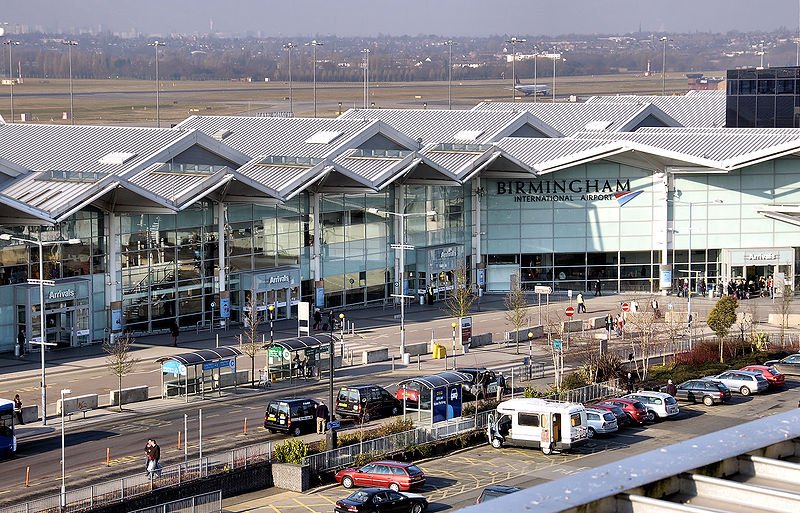 View of Birmingham with the Bartley Green Reservoir in the foreground: Source: https://commons.wikimedia.org/wiki/File:Birmingham_Skyline_from_Bartley_Green.jpg
View of Birmingham with the Bartley Green Reservoir in the foreground: Source: https://commons.wikimedia.org/wiki/File:Birmingham_Skyline_from_Bartley_Green.jpgAuthor: JimmyGuano

Birmingham is the second biggest city in the United Kingdom after London. It has a population exceeding 2.2 million people. Together with the surrounding towns, the metropolitan area of Birmingham has a population of 3.6 million. The city is a metropolitan borough in the West Midlands.
The city of Birmingham is at the heart of the Industrial Revolution in England. This city was the engine for the many of the manufacturing industries in England. Although the manufacturing sector has declined in importance in Birmingham - as well as in much of Britain - Birmingham has reinvented itself as a regional commercial centre. It has been voted the second best place in the United Kingdom to locate a business, outside of London itself.
 St Philip's Cathedral, Birmingham: Source: https://commons.wikimedia.org/wiki/File:St_Philips_Cathedral,_Birmingham_from_the_east.jpg
St Philip's Cathedral, Birmingham: Source: https://commons.wikimedia.org/wiki/File:St_Philips_Cathedral,_Birmingham_from_the_east.jpgAuthor: JimmyGuano

The Birmingham area has been settled as far back as over 10,000 years ago. The city itself began as a farming village back in the early 7th century. The name Birmingham is believed to have been developed from "Beorma inga ham", which means "farmstead of the sons of Beorma". Birmingham became a market town with the royal charter granted in 1166 to hold a market.
Birmingham's role as a manufacturing centre can be traced back to the 17th century, with the English Civil War, when the town became the manufacturing base for small arms. The Industrial Revolution beginning in the mid-18th century ushered in an era of growth and prosperity for the town, and its population increased manifold. By the Victorian era, it has become the second biggest town in England, with a population exceeding half a million. In 1889, it was granted city status by Queen Victoria.
Birmingham suffered heavy bombing during the Second World War, requiring extensive rebuilding in the 1950's and 60's. By then its ethnic composition has begun to shift with immigrants from the Commonwealth countries coming to settle in the city.
 Birmingham International Airport: Source: https://commons.wikimedia.org/wiki/File:Birmingham_airport_arrivals_arp.jpg
Birmingham International Airport: Source: https://commons.wikimedia.org/wiki/File:Birmingham_airport_arrivals_arp.jpgAuthor: Adrian Pingstone

Going to Birmingham
By Plane: Birmingham International Airport is roughly 8 miles to the east of downtown. The best way for budget travellers to leave the airport is to take the AirRail Link, a rapid transit people mover to the airport's railway station, and from there, take a train to the New Street Station in downtown Birmingham. The journey from the airport to downtown Birmingham takes between 10 to 20 minutes and costs £3 for the local service and £7 for the express service.You can make the same journey by taxi for &22, but it will actually take a little longer, between 20-30 minutes, to wade through Birmingham traffic to reach downtown.
 Edmund Street, Birmingham, England: Source: https://commons.wikimedia.org/wiki/File:Edmund_Street,_Birmingham,_England.JPG
Edmund Street, Birmingham, England: Source: https://commons.wikimedia.org/wiki/File:Edmund_Street,_Birmingham,_England.JPGAuthor: Erebus555

By Train: The Birmingham New Street Railway Station is the transportation hub of the city. This is also the station where the train from the airport arrives. You can take the train from the London Marylebone Station to Birmingham New Street station. There are also trains to Birmingham from Bristol, Cardiff, Edinburgh, Glasgow, Manchester, Oxford and Sheffield.
By Bus: Intercity buses connect Birmingham with most of the cities in the United Kingdom. The terminus for the buses in Birmingham is temporarily at the Birmingham Central Coach Station while the Digbeth Coach Station is being rebuilt.
Going around Birmingham
You can take the bus, the train as well as the Metro in Birmingham. They are all under the authority of Network West Midlands.Places of Interest in Birmingham
- Birmingham Botanical Gardens: Huge garden with a diverse collection of plants.
- Birmingham Mosque: Second purpose-built mosque in the United Kingdom.
- Bullring Shopping Centre: Shopping centre with cutting edge architecture.
- Cadbury World: Centre dedicated to showcasing and celebrating chocolates.
- City Museum and Art Gallery: Museum in a Neo-Classical building with outstanding collection of art,
- National Exhibition Centre: Major exhibition centre in Birmingham.
- Thinktank - the Birmingham Museum of Science and Discovery: Museum celebrating Birmingham's role in engineering, aircraft and automobile industries.
- Sarehole Mill: One of the 17th century water mills still existing in Birmingham.
- Soho House: Home of industrial pioneer Matthew Boulton.
- St Chad's Cathedral: Cathedral of the Roman Catholic diocese of Birmingham, designated a minor basilica in 1941.
- St Philip's Cathedral: Cathedral of the Anglican diocese of Birmingham.
Birmingham is  on the Map of cities in England
on the Map of cities in England
 Latest updates on Penang Travel Tips
Latest updates on Penang Travel Tips
Map of Ceremonial Counties of England

Copyright © 2003-2025 Timothy Tye. All Rights Reserved.

 Go Back
Go Back